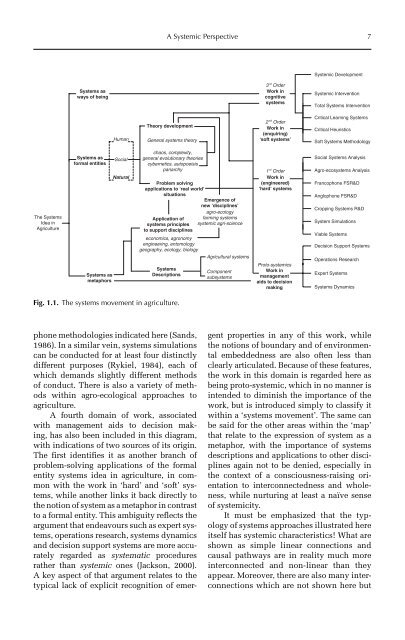Redesigning Animal Agriculture
Redesigning Animal Agriculture
Redesigning Animal Agriculture
You also want an ePaper? Increase the reach of your titles
YUMPU automatically turns print PDFs into web optimized ePapers that Google loves.
The Systems<br />
Idea in<br />
<strong>Agriculture</strong><br />
Systems as<br />
ways of being<br />
Systems as<br />
formal entities<br />
Systems as<br />
metaphors<br />
phone methodologies indicated here (Sands,<br />
1986). In a similar vein, systems simulations<br />
can be conducted for at least four distinctly<br />
different purposes (Rykiel, 1984), each of<br />
which demands slightly different methods<br />
of conduct. There is also a variety of methods<br />
within agro-ecological approaches to<br />
agriculture.<br />
A fourth domain of work, associated<br />
with management aids to decision making,<br />
has also been included in this diagram,<br />
with indications of two sources of its origin.<br />
The first identifies it as another branch of<br />
problem-solving applications of the formal<br />
entity systems idea in agriculture, in common<br />
with the work in ‘hard’ and ‘soft’ systems,<br />
while another links it back directly to<br />
the notion of system as a metaphor in contrast<br />
to a formal entity. This ambiguity reflects the<br />
argument that endeavours such as expert systems,<br />
operations research, systems dynamics<br />
and decision support systems are more accurately<br />
regarded as systematic procedures<br />
rather than systemic ones (Jackson, 2000).<br />
A key aspect of that argument relates to the<br />
typical lack of explicit recognition of emer-<br />
A Systemic Perspective 7<br />
3 rd Order<br />
Work in<br />
cognitive<br />
systems<br />
Systemic Development<br />
Systemic Intervention<br />
Total Systems Intervention<br />
Critical Learning Systems<br />
2 nd Order<br />
Theory development<br />
Work in<br />
(enquiring)<br />
Critical Heuristics<br />
Human General systems theory ‘soft systems’<br />
Soft Systems Methodology<br />
chaos, complexity,<br />
Social general evolutionary theories<br />
cybernetics, autopoeisis<br />
panarchy<br />
1 st Order<br />
Natural Work in<br />
Problem solving<br />
applications to ‘real world’<br />
situations<br />
Emergence of<br />
new ‘disciplines’<br />
Application of<br />
systems principles<br />
to support disciplines<br />
economics, agronomy<br />
engineering, entomology<br />
geography, ecology, biology<br />
Systems<br />
Descriptions<br />
Fig. 1.1. The systems movement in agriculture.<br />
agro-ecology<br />
farming systems<br />
systemic agri-science<br />
Agricultural systems<br />
Component<br />
subsystems<br />
(engineered)<br />
‘hard’ systems<br />
Proto-systemics<br />
Work in<br />
management<br />
aids to decision<br />
making<br />
Social Systems Analysis<br />
Agro-ecosystems Analysis<br />
Francophone FSR&D<br />
Anglophone FSR&D<br />
Cropping Systems R&D<br />
System Simulations<br />
Viable Systems<br />
Decision Support Systems<br />
Operations Research<br />
Expert Systems<br />
Systems Dynamics<br />
gent properties in any of this work, while<br />
the notions of boundary and of environmental<br />
embeddedness are also often less than<br />
clearly articulated. Because of these features,<br />
the work in this domain is regarded here as<br />
being proto-systemic, which in no manner is<br />
intended to diminish the importance of the<br />
work, but is introduced simply to classify it<br />
within a ‘systems movement’. The same can<br />
be said for the other areas within the ‘map’<br />
that relate to the expression of system as a<br />
metaphor, with the importance of systems<br />
descriptions and applications to other disciplines<br />
again not to be denied, especially in<br />
the context of a consciousness-raising orientation<br />
to interconnectedness and wholeness,<br />
while nurturing at least a naïve sense<br />
of systemicity.<br />
It must be emphasized that the typology<br />
of systems approaches illustrated here<br />
itself has systemic characteristics! What are<br />
shown as simple linear connections and<br />
causal pathways are in reality much more<br />
interconnected and non- linear than they<br />
appear. Moreover, there are also many interconnections<br />
which are not shown here but










